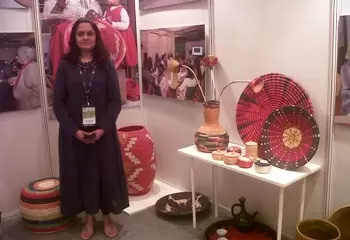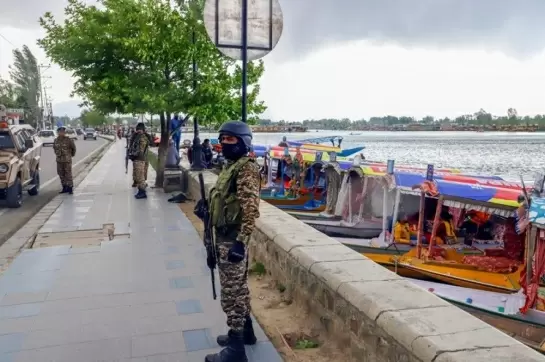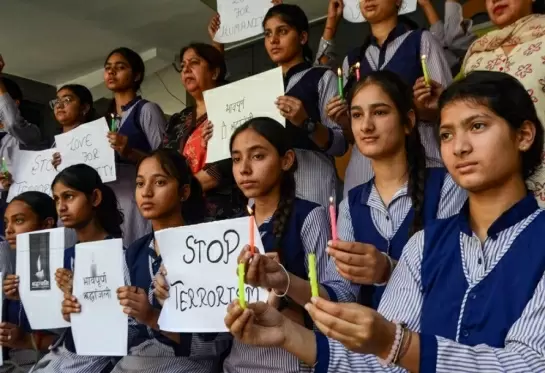An initiative aimed at empowering poor rural women of Africa
15-March-2014
Vol 5 | Issue 11
A new initiative has India partnering with African countries to empower African women by developing skills that already exist within them.
Displayed in the middle of corporates and surrounded by technology companies, engineering as well as IT solution providers at the exhibition being held as part of the 10th CII-EXIM Bank Conclave on India Africa Project Partnership in New Delhi is the India Africa Craft Design Initiative that aims at supporting women in Africa.
"If one looks at the issues that have been discussed here at the conclave it is all big stuff but focusing on women in rural areas is absolutely essential too," said Prisca N. Nemapare, chief program officer of the Zienzele Foundation in Zimbabwe.
"This conclave would help this project with exposure by creating market linkages and help small organizations with big impacts by way of funding, education or any other support that the communities may need," she said, adding that India's National Institute of Design (NID) has helped women in Africa in using their talent in the best possible manner.
 |
|
The products on display at the exhibition have been made by rural women in Africa (Photo: IANS)
|
The products on display at the exhibition are made by rural women in Africa who are struggling to make a living and support their families.
The India Africa Craft Design Initiative has helped these women develop and improve their skills in making products they have already been making.
The project in Zimbabwe as the pilot country started in March 2012. After an extensive in-country field visit, two weaver groups were selected as the beneficiaries for the training workshops -- the sisal basket weavers of Zienzele Foundation and the bamboo weavers from the STEP Trust.
Over and above the training imparted for skills and product development, the other significant aspect of the project in Zimbabwe was the transfer of basic technology wherein the bamboo weavers were introduced to hand tools and manually operated equipment.
Twenty new products, each of sisal and bamboo, have now been developed with good market potential.
Fifty basket weavers were directly trained in the workshops. The new product ranges were showcased at the National Gallery of Zimbabwe in Harare in November 2012.
An exhibition-cum -buyer-seller meet was held in New Delhi in March 2013 to explore and develop suitable market linkages for such products in India.
"These women are now receiving orders and are busy with designing using the new skills they have acquired from the workshops, field visits and training," Nemapare said.
"Projects like these should be carried out and implemented in various African countries for married women who struggle with shortage of income and widows who are being forgotten".
Ghana was the second country where the project moved to in October 2013, after its successful culmination in Zimbabwe. The country has profoundly high levels of skills in basket weaving and a lot of its baskets are exported to western European countries.
The field visits revealed that there is a major concentration of basket weavers in the country's northern town of Bolgatanga who use elephant grass to weave exquisitely patterned baskets.
Since the Bolga weavers represent a majority of the basket making activity in Ghana, weavers from different craft-based organizations based in Bolgatanga were chosen for training under the project.
The project in Ghana is under way and the final in-field workshop will be held in April 2014.
So far, 20 weavers have been trained through workshops in the country and at NID in India. A group of around 30 weavers are expected to participate in the last workshop.
So far, a range of 30 products have been developed ranging from personal accessories to lifestyle products with interesting integration of leather and wood as secondary materials, adding further value to the products.
The project in Ethiopia, a country that offers great diversity of materials used for basket making, was initiated in November, 2013.
An overview of the field visits and interactions with weavers of different groups led to the identification of six clusters -- Bochesa, Kelo, Lepis, East Langano, Tulugudu and Harar -- where weavers can be trained under the project.
The multiple materials and skills available have resulted in a very rich exchange of the participant weavers at several levels. Needless to mention, it has added variety to the products in terms of techniques and structures, forms, colors and patterns.
Twenty weavers were offered training in a workshop at NID, while a workshop in Ethiopia's capital Addis Abeba trained 30 weavers, most of whom had already gone through an earlier round of training which enabled them to move their competence to the next level.
Around 70 new products have been developed ranging from personal accessories to products such as lighting objects, space dividers, furniture, table top accessories and jewellery.
"What we tried to do as a design team was to go to each country's culture rather than bringing in alien elements and impose these on the participants", Shimul Mehta Vyas, activity chairperson in the Faculty of Textile, Apparel and Accessory Design at NID, said.
This project just does not end in three workshops and training, according to Shimul, but is also committed to creating market opportunities and get some linkages.
"We have to give a couple of years to really develop their products and make their products competitive and of international standard,” she said.
However, she also stated that "we are very happy with the way they have responded to the training.”
"We are going to engage more deeply in Africa and we look forward to more active participation," she added. - IANS














